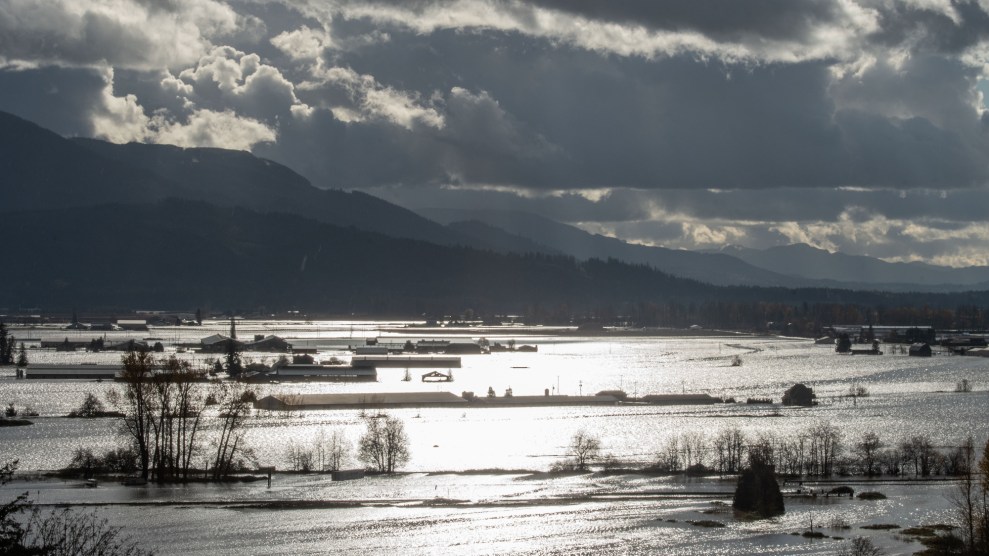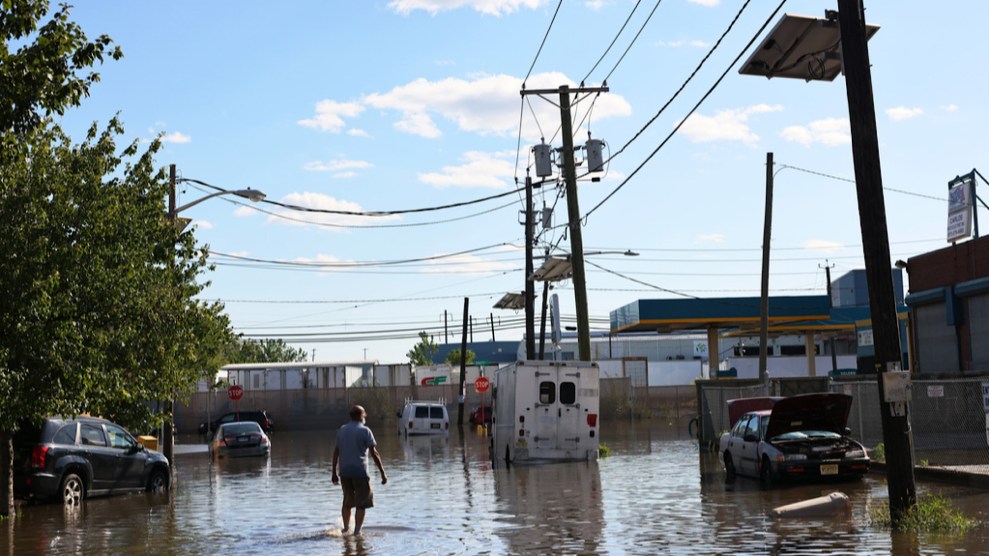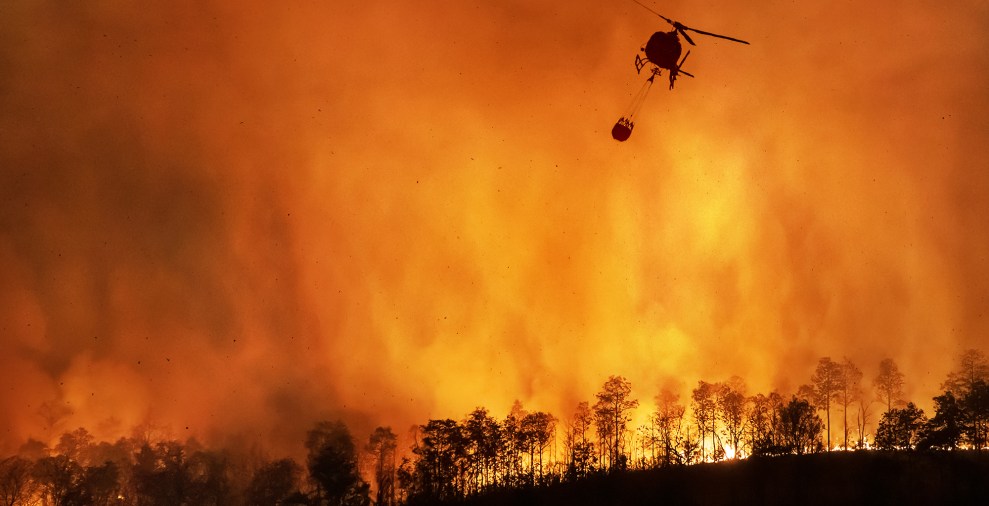
The Sumas Prairie near Abbotsford, British Columbia after a series of storms led to flooding that devastated farms in Canada and Washington state. Quinn Bender/ZUMA
This story was originally published by the Food and Environment Reporting Network.
In November, when a string of catastrophic storms hit the Pacific Northwest, the Nooksack River flooded, submerging farming communities in both the US and Canada. Cows were swept away, and farmers raced to save them on boats and jet skis. By the time the waters subsided, thousands of farmers and farmworkers had lost their livelihoods—particularly in British Columbia—and a long-running dispute over how best to manage the Nooksack had gotten a lot worse. It’s a fight that pits farmers against Native communities, the US against Canada, and the demands of development against the demands of conservation. In short, it’s the kind of fight that many Westerners have seen before.
As climate change intensifies, rivers like the Nooksack throughout the West are becoming less predictable. They’re running shallow in prolonged droughts or extreme heat, then flooding during volatile storms—and that unpredictability is exacerbating old conflicts between farmers and conservationists over how those rivers should be managed. In the case of the Nooksack, farmers on both sides of the border say the US could save their communities if it managed the river more aggressively, with regular dredging and other flood-control measures. But Indigenous groups—and the scientists who agree with them—say such changes could be disastrous to a river that’s already at risk of ecosystem collapse.
“It’s an existential threat,” says John McLaughlin, an associate professor of environmental science at Western Washington University who’s studied the Nooksack, of the river’s fragility. “It ought to be a wake up call to everyone. And the solutions are also going to take everyone.”
A lot of talk, but no answers
The Nooksack River starts near the foot of Mount Baker, which at a mere 140,000 years old is one of the youngest volcanoes in Washington’s Cascade Mountains. Fed by glacier melt and heavy snowfall, the river cuts through the mountains and pours into the lowlands, where its banks are dotted by dairies and blueberry farms. A lot of the Washington farm towns and British Columbia (BC) dairies that were decimated last November sit in the same green valleys, which are somewhat arbitrarily interrupted by the US-Canadian border. The Nooksack runs along the Washington side and loops its way to the Lummi Indian Reservation, then empties into Bellingham Bay.
The Nooksack has always flooded. And even though it doesn’t run through Canada, it has long spilled over the border from time to time, too, refilling ancient tributaries. The river swells and contracts based on rain and snow melt, and in part because its headwaters are so close to an active volcano it picks up a heavy load of silt, sand and gravel as it weaves through the mountains. That sediment creates fertile spawning grounds for salmon and other fish, but it also raises the water level, exacerbating the flooding.
“The Nooksack River system does not have a dam on it,” says Jay Gordon, the Washington State Dairy Federation’s policy director. “Not one. And so it comes roaring out [of the mountains] with no flood control system of any kind, and it hits the lowlands.” Some lowland farming communities keep the waters at bay with dikes, but the Nooksack occasionally overwhelms them. Gordon describes parts of the lowlands as “a bathtub,” where flood waters pool and can sit for weeks without draining.
To some farmers and local officials on both sides of the border, there’s a clear solution to this problem: The US needs to dredge the Nooksack. Washington State used to dredge it regularly by allowing contractors to mine the river for gravel, but the mining stopped about 30 years ago when its regulatory oversight became more onerous. In the 1990s, regulatory agencies and the Nooksack and Lummi Nations became concerned that the gravel mining was disrupting salmon spawning grounds. The Chinook is protected in the US by the Endangered Species Act.
In the years since, the Nooksack’s waters have gotten higher, rising up to three feet in some places. “I am told that there are now places in Washington State that are literally below river level,” says Mike de Jong, who represents some of the hardest-hit farming communities in BC’s Legislative Assembly. “And that is the result of purposeful decisions.”
De Jong got into BC politics in the early 1990s, in the aftermath of another devastating flood of the Nooksack. “I ended up in Washington, DC, meeting with the Army Corps of Engineers” about how to manage the river, he says. But after decades of bureaucratic wrangling, very little has gotten done.
Bottom of Form
In the 1990s, the US and Canada launched the Nooksack River International Task Force. It issued reports and addressed local emergency communications, but it has yet to resolve conflicts over how the Nooksack is managed. For over a century, the two countries also have arbitrated water disputes through the International Joint Commission (IJC), but it hasn’t weighed in on the Nooksack’s management. (The IJC did not respond to a request for comment by publication.) By the time the rains started falling last November, stakeholders had been talking about the Nooksack for 30 years without changing much of anything. The river wasn’t dredged. The waters kept rising. And when a series of historic storms blew through—fueled in part by climate change—the lowlands didn’t stand a chance.
Now, the Washington Dairy Federation and other farming advocacy groups are pushing for new state legislation, which policy director Gordon says would address the Nooksack’s sediment management. And in Canada, de Jong is exploring a strategy of last resort: suing the US for damages. “When something escapes a property and damages a neighbor’s property, the first neighbor is ultimately responsible,” he said in a recent interview. “That’s a pretty basic legal principle.”
Canadian legal experts say a case like this would be unlikely to succeed, and de Jong still hopes the IJC will arbitrate the dispute. But he also says the lawsuit might finally get the right people’s attention. That way, he says, “The proper steps can be taken to ensure that folks [in communities like] Whatcom County and Abbotsford aren’t having to shoot their cows because they’ve been standing in neck deep water for a week and a half.”

A river in ‘grave danger’
The November flood turned Washington’s Lummi Indian Reservation into a swampy island. “It was the worst flooding that I’ve seen,” Lisa Wilson, a Lummi Nation Council member, told me in a call from her car between meetings. The tribe’s police department rescued residents with boats and, at one point, a dump truck, ferrying families to safety at the Silver Reef Casino. Wilson says several families have been permanently displaced.
But in December, when a member of the Whatcom County Council in Washington proposed researching gravel removal from the Nooksack, tribal leaders sent a letter to the council spelling out their opposition. The response of the Nooksack Tribe, which also relies on the river, was even more strident: for tribal leadership to even consider dredging the river, the process must have no impact on the salmon population.
Salmon have sustained the Lummi people’s way of life for thousands of years. The fish are a cornerstone of their traditional diet, and they honor the salmon ceremonially. “If they were to go extinct on our watch, it would be like we had failed our ancestors,” says Wilson. “We would lose our identity as the salmon people.”
Traditionally, the Nooksack teemed with salmon, which are essential to the local ecosystem. Bears, seals and endangered orcas all rely on salmon for food. As climate change fuels extreme weather events, the Nooksack’s run is at risk of dying out. Months before the Nooksack flooded, its waters ran low during a deadly heat wave, killing at least 80 percent of Chinook salmon trying to reach their spawning groups.
Wilson describes the tribe’s efforts to save the salmon as a “sacred obligation.” She says they have increasingly bolstered the Nooksack’s runs with fish from their hatcheries, and have been locked in an arduous legal process to clarify their water rights for years. “We are the ones that are producing the fish,” she says. “We are the ones that are fixing the habitat.”
According to Wilson, a rushed dredging of the Nooksack River is the last thing this ecosystem needs, and government agencies in Washington State agree with her. “Recovering habitat for salmon is critically important,” says David Radabaugh, coordinator of the National Flood Insurance Program at Washington’s Department of Ecology. “You pull gravel out of a river, upset the system? That’s going to degrade habitat.”
Radabaugh and his colleagues sympathize with farmers who were paralyzed by recent flooding. But as Curt Hart, the Department of Ecology’s communications manager, delicately put it, “Canada doesn’t have the same sort of rigorous Endangered Species Act as the United States.” A gravel mining operation would need to demonstrate compliance with federal environmental law, as would an expansion of levees or other potential fixes.
Besides, says Radabaugh, “If we remove gravel, does that solve the problem? With a flood of this size? I don’t think that’s a question that’s been answered.”
The Nooksack wasn’t the only source of November’s floods—parts of the Pacific Northwest received over two feet of rain that month. And while farmers blame the floods on decades of red tape and controversial river management, Native leaders and scientists point to other, much older decisions that are part of the problem, too.
Farmers on both sides of the border built their farms in the Nooksack’s floodplain, where the soil was richest. On the Washington side, settlers logged the forests that lined the Nooksack’s banks and paved swaths of land in the river’s basin, removing crucial flood barriers.
On the BC side, development was even more dramatic. About a hundred years ago, the lowlands were the site of a large lake, but the Canadian government drained it in the 1920s, turning it into some of the country’s most valuable farmland. When the Nooksack jumped its banks in November, the flood waters naturally settled where the lake used to be. BC farmers were devastated, but residents of Canada’s Sumas First Nation, whose elders had warned them to build on higher ground, were largely spared. “It is something that our people never would have even thought of doing, altering nature in such a way,” Dalton Silver, chief of the Sumas First Nation, said of the decision to drain the lake.
Now, this history of shortsighted development has put the Nooksack in “grave danger,” according to John McLaughlin of Western Washington University. In a recent study of the Nooksack, McLaughlin focused on six aspects of river health, including the vibrancy of nearby forests and the strength of the river’s flow in the summer. In five out of six categories, he concluded, the ecosystem had already passed what he calls a “global boundary”—the point at which the river can safely avoid collapse. Climate change is only compounding the problem.
Ecosystem collapse would mean the extinction of Chinook salmon, McLaughlin says. It would also mean less water for farmers—and more flooding. “I use an analogy of a road highway with a guardrail on it,” he says. “You must not cross that, or you risk bad consequences. If you cross it and haven’t hit the bottom yet, you might think everything’s fine—but you are now committed to catastrophe.”
No perfect answer
McLaughlin says dredging and other proposed fixes, like expanding dikes or levees, could further upend the fragile ecosystem. The solutions he prefers take time. “Restoring floodplain forests, for sure,” he says. “Restoring log jams, maybe even restoring beavers.” In the meantime, the Department of Ecology’s Dave Radabaugh is working with Washington communities to help them adapt to future flooding, but the flood line is hard to anticipate as the climate shifts around them. “How much higher should we build?” he says. “There’s no perfect answer to that.”
Neither of these solutions satisfies the farmers who live in the floodplain. “If we can keep people living in outer space for six months at a time, I feel like there should be some way to come together and clean gravel out of the river without damaging salmon,” says Joe Jacobs, a BC dairy farmer who was marooned on his property for days during the November floods. “I kind of feel like it’s not ever going to be fixed.” At a recent meeting in Washington’s Whatcom County, local officials presented a proposal to buy out damaged homes and create a floodway, which would divert a future flood away from farm communities. It would also divert the water into Canada. “They’re looking out for themselves,” BC resident Caroline Mostertman told the Vancouver Sun last week.
If there’s one thing the Nooksack’s many stakeholders agree on, it’s that something needs to change. Most of them also insist they want to work together, and that there’s a compromise to be found, even if no one quite knows what it is yet. “Doing nothing is not a good option right now,” says Jay Gordon of the Washington Dairy Federation. “So are we going to take a risk and do something?”
The Lummi Nation’s Lisa Wilson says tribal leaders have met with state representatives, and “we are definitely in different processes with the farmers as well.”
She insists the tribe isn’t against managing the Nooksack River—far from it. Members are open to fixing culverts and tide gates, restoring wetlands that could better absorb floodwaters, and other reforms. Some tribal members are even open to dredging. What the Lummi Nation is wary of, says Wilson, is the myopic way that officials in Washington State and BC have managed rivers in the past. An elder who’s mentored her for a number of years has described it as a vicious cycle: non-native people use a natural resource to its maximum limits and beyond. When disaster strikes, they complain about the sudden lack of that resource. Then they ask for more of it. They’re surprised when disaster strikes again.
“You’re not going to win against nature,” Wilson says. “And we’re in unprecedented times.”












